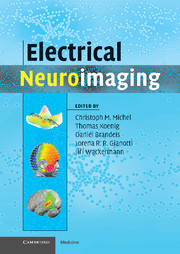Book contents
- Frontmatter
- Contents
- List of contributors
- Preface
- 1 From neuronal activity to scalp potential fields
- 2 Scalp field maps and their characterization
- 3 Imaging the electric neuronal generators of EEG/MEG
- 4 Data acquisition and pre-processing standards for electrical neuroimaging
- 5 Overview of analytical approaches
- 6 Electrical neuroimaging in the time domain
- 7 Multichannel frequency and time-frequency analysis
- 8 Statistical analysis of multichannel scalp field data
- 9 State space representation and global descriptors of brain electrical activity
- 10 Integration of electrical neuroimaging with other functional imaging methods
- Index
- References
5 - Overview of analytical approaches
Published online by Cambridge University Press: 15 December 2009
- Frontmatter
- Contents
- List of contributors
- Preface
- 1 From neuronal activity to scalp potential fields
- 2 Scalp field maps and their characterization
- 3 Imaging the electric neuronal generators of EEG/MEG
- 4 Data acquisition and pre-processing standards for electrical neuroimaging
- 5 Overview of analytical approaches
- 6 Electrical neuroimaging in the time domain
- 7 Multichannel frequency and time-frequency analysis
- 8 Statistical analysis of multichannel scalp field data
- 9 State space representation and global descriptors of brain electrical activity
- 10 Integration of electrical neuroimaging with other functional imaging methods
- Index
- References
Summary
The general model
The aim of this chapter is to introduce a structured overview of the different possibilities available to display and analyze brain electric scalp potentials. First, a general formal model of time-varying distributed EEG potentials is introduced. Based on this model, the most common analysis strategies used in EEG research are introduced and discussed as specific cases of this general model. Both the general model and particular methods are also expressed in mathematical terms. It is however not necessary to understand these terms to understand the chapter.
The general model that we propose here is based on the statement made in Chapter 3, stating that the electric field produced by active neurons in the brain propagates in brain tissue without delay in time. Contrary to other imaging methods that are based on hemodynamic or metabolic processes, the EEG scalp potentials are thus “real-time,” not delayed and not a-priori frequency-filtered measurements. If only a single dipolar source in the brain were active, the temporal dynamics of the activity of that source would be exactly reproduced by the temporal dynamics observed in the scalp potentials produced by that source. This is illustrated in Figure 5.1, where the expected EEG signal of a single source with spindle-like dynamics in time has been computed. The dynamics of the scalp potentials exactly reproduce the dynamics of the source. The amplitude of the measured potentials depends on the relation between the location and orientation of the active source, its strength and the electrode position.
- Type
- Chapter
- Information
- Electrical Neuroimaging , pp. 93 - 110Publisher: Cambridge University PressPrint publication year: 2009
References
- 3
- Cited by



